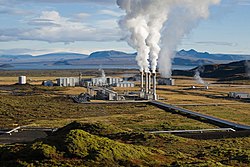Power station


A power station (or power plant) is a place where electricity is produced. Most do this by a big spinning electrical generator. In big powers stations the spinning is usually driven by a steam turbine. The steam may come from:
- Burning fossil fuels
- Nuclear power, using radioactive sources
- Using the earth's heat, called geothermal energy
- Using the sun's heat
Some do not use steam engines to spin the generator. Rather they use:
- Hydropower, which uses the power of moving water to drive turbines
- Using the wind to drive wind turbines
- Internal combustion engine power
A few power stations use the sun's rays to generate solar power without motion. There are many power stations around the world, because many things need electricity to work.
Stations may be operated as Load following power plant, peaking power plant, or base load power plant.
Energy sources
Renewable energy resources
- Renewable heat energy
- Renewable flow energy
Non-renewable energy resources
These all use heat as a source of energy.
Solid-state electricity sources
These sources have no moving parts. They are more expensive than generators, and are used where other questions are more important.
Power Station Media
The Niederaussem Power Station is the largest coal power plant in Germany
The generator room of the Krka hydroelectric plant (1895), with one of the first polyphase AC distribution systems in the world
A large gas and coal power plant in Martinlaakso, Vantaa, Finland
Cooling towers showing evaporating water at Ratcliffe-on-Soar Power Station, United Kingdom
"Camouflaged" natural draft wet cooling tower
Hydroelectric power station at Glen Canyon Dam, Page, Arizona
Other websites
![]() Media related to Power plants at Wikimedia Commons
Media related to Power plants at Wikimedia Commons









